‘The Green Frame of British Rule?’ – Irish in the Indian Civil Service
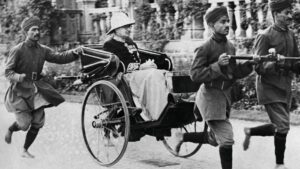
By Seán William Gannon
In British-ruled India, a few tens of thousands of British administrators and soldiers ruled over between 2 to 300 million Indians.
The recent centenary of the execution of Connaught Rangers’ mutineer Private James Daly served as a reminder of the extent of Irish military service in colonial India. By the mid-nineteenth century, Irish soldiers like Daly comprised between 40 and 50 percent of British military personnel there stationed and, while this was the high watermark in terms of their representation, they maintained a significant presence in India’s British garrison until independence in 1947.[1]
However, the Indian adventures of these soldiers formed part of a wider Irish engagement with empire-building in the Raj through settlement, missionary work, and enlistment in its civilian imperial services such as the Public Works Department, the Indian Police Service, the Indian Medical Service (a military corps of doctors and surgeons which performed a broad civil function) and, most importantly, the Indian Civil Service (ICS).
The Indian Civil Service under the British Raj
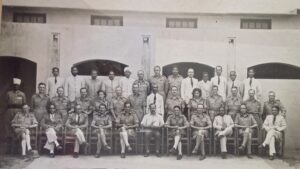
Irish enlistment in the ICS began in earnest in the late 1850s when ‘British India’ formally became a Crown charge. It had previously been ruled by proxy – conquered, consolidated, and governed by the East India Company (EIC), a private joint-stock company based in the City of London. Under royal charter and loose regulation, the EIC’s ‘merchant-statesmen’ and their civil service administered India (assisted by private armies) for corporate gain.
The British Government used the opportunity provided by the Indian Rebellion of 1857-58 to nationalize this de facto empire and, under the Government of India Act of 1858, EIC control was ceded to the India Office, a newly formed executive department of state. However, changes to company recruitment practices had already been instituted by this time. The EIC had long filled its ICS through patronage: company directors personally nominated young men for internships, four such nominations being required.
The Indian Civil Service was founded after the British government assumed responsibility for the government of India from the East India Company
On passing an entrance examination, nominees were enrolled as ‘writers’ in the EIC’s training college in Haileybury, where they undertook two years of study in Indian political economy, languages, and law. They went afterwards to India and, following further language study, were given a covenanted ICS appointment. Mindful that India would eventually convert to direct Crown control, the British Government decided to use a renewal of the EIC’s charter in 1853 to change the nomination system.[2]
Under the provisions of the Government of India Act passed in August, nomination in the ICS was replaced by recruitment through open competitive examination. The first such examination was held in June 1855, Haileybury was closed in January 1858, and pre-appointment training was transferred to the university setting. There, this ultimately took the form of one or two-year ‘probationerships’ at approved colleges during which candidates studied Indian history and cultures, political economy, languages, and law. The attainment of a ‘minimum proficiency’ in equestrianism was also required.
The introduction of the competitive principle did not seek to transform the ICS into a source of employment for all educated young men of proven merit. On the contrary, it was intended to ensure the population of the ICS by what one contemporary called ‘the picked men of the universities’, primarily Oxford and Cambridge.[3]
For the ICS examination’s subject structure was weighted towards English elite education curricula, on the basis that UK society’s aristocratic and upper-middle class elements would alone have the access required for success. However, the emergence of grind schools or ‘crammers’ teaching the examination curriculum, most famously Wren and Gurney in London, ensured significant broader ICS entry, to general British establishment dismay.
Irish Education for Imperial Service
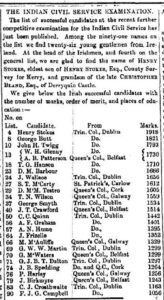
Ireland’s elite education infrastructure immediately adapted to exploit the opportunity provided by the introduction of competitive recruitment. Some intermediate schools began specializing in the preparation of students to sit the examinations, most notably Dr Stackpoole’s in Kingstown (today Dun Laoghaire).
It produced 30 Civilians (as covenanted Indian civil servants were called) between 1855 and 1870, earning ‘a reputation second to none in the United Kingdom for the success of it pupils at the examinations’.[4]
More importantly, Ireland’s expanding network of elite intermediate colleges, both Protestant and Catholic, promoted the ICS as a career and the appointment of an ‘old boy’ became a badge worn with great pride in institutions such as Portora Royal, St Columba’s, and Clongowes. In addition, crammers were established in Belfast and Dublin, including a specifically Catholic ‘coaching school’ opened in Donnybrook, Dublin, in 1870.
Irish universities also rowed in. Trinity College Dublin (TCD) and the Queen’s Colleges, which were of necessity more vocational in focus than their British counterparts, reoriented their curricula to cover the subjects examined such as Indian languages (for example, Hindustani, Arabic, and Sanskrit), history, and law, as well as medical topics pertinent to colonial practise such as sanitation and tropical disease.
The introduction of competitive examinations for the ICS opened it to young men outside of the British ruling class, including Irishmen of various origins.
Similarly, at Ireland’s Catholic University, which saw in examination success a means of validating its status; as the Daily Express contemptuously put it, ‘a place obtained in the annual Indian competition will secure more respect for the “Catholic University” than all the processions of all the ragamuffins in the world in favour of a charter it will never get’.[5]
These initiatives resulted in an upsurge in Irish ICS appointments. While Irishmen had accounted for less than 5 percent of the Civilians that came through Haileybury between 1809 and 1850, 24 percent of Civilians appointed between 1855 and 1863 were educated in Ireland (30 percent or over in 1857, 1858 and 1861), at a time when the country accounted for roughly 20 percent of the UK population.[6]
Irish success was acknowledged in 1877 through the opening of an Indian Civil Service School in TCD, at which successful examinees could complete the probationership required. Yet, while the scale of Irish appointments was considered what the Irish Times termed ‘a National Triumph’ at home, it quickly became a cause of British concern.[7]
‘Competition Wallahs’ and ‘English Gentlemen’
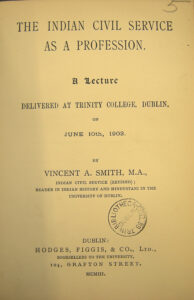 Certainly, the general calibre of the so-called ‘competition wallahs’ (that is those who qualified for the ICS via competitive exams) was criticized in many quarters. Some believed that the ICS required men with ‘more fire in their belly than thought in their mind’ and what one contemporary termed the ‘priggish pedants [and] polished dunces’ who passed the examination simply did not fit the bill.[8]
Certainly, the general calibre of the so-called ‘competition wallahs’ (that is those who qualified for the ICS via competitive exams) was criticized in many quarters. Some believed that the ICS required men with ‘more fire in their belly than thought in their mind’ and what one contemporary termed the ‘priggish pedants [and] polished dunces’ who passed the examination simply did not fit the bill.[8]
For others, the preponderance of what the permanent secretary to the Treasury (and former EIC ‘writer’ and distinguished Civilian), Charles Trevelyan, termed ‘Sizars and Servitors’, and crammer-prepped middle-class non-graduates, lacked ‘the impalpable qualities’, through the force of which ‘the English gentleman’ governed overseas.[9]
However, Irish ‘competition wallahs’ were singled out for particular derision, so much so that the Irish Times claimed that it was ‘the success of Irishmen in the competition which [gave] Englishmen such a disgust against the system’.[10]
For instead of drawing in the desired Oxbridge-educated gentlemen-rulers, the India Office believed that the system was facilitating the appointment of what its then secretary, Sir Charles Wood, described as ‘well crammed youths from Irish Universities and Commercial Schools’ who, coarse and uncultured, lacked both the social competences and paternalistic instinct towards Indians it believed was required of successful Civilians.[11]
Some in Britain bemoaned the success of ‘crammed’ ‘competition wallahs’ over true ‘English gentlemen’ in appointments to the ICS
Some felt that the Irish were further unfitted because of their political and/or religious conditioning. Three years after open competition’s introduction, the Saturday Review noted that, while the Irish and the Scots were ‘equally noted for their local patriotism and their narrow religious practices’, the Scots were better able to govern foreign peoples of different faiths.
It therefore warned against ‘substituting Irishmen for Scotchmen in the Civil Government of India’, adding that ‘Englishmen, who are impartial judges of the question, may be allowed to ask whether the empire gains by the exchange’.[12]
Wood was so alarmed by what he saw as the ICS’s creeping Hibernicization that he changed the examination criteria to stymie Irish success. Most notably, he reduced by one-quarter the points allocated to examination subjects in which Irish candidates were seen to excel such as Arabic and Sanskrit (Irish entrants achieved the highest marks in Sanskrit in 1860 and in both Arabic and Sanskrit in 1862) and increased those for subjects in which English public school-educated candidates were perceived to have the advantage, viz. Latin and Greek.[13]
This, coupled with factors such as increasing domestic employment opportunities for the Irish middle class, saw Irish appointments decline, reaching the Haileybury-era rate of 5 percent in the 1880s. This figure slightly improved in the 1890s and hovered between 5 and 10 percent until 1914, by which time almost 300 Irish Civilians had served.[14]
The Social Composition of Irish ‘Civilians’
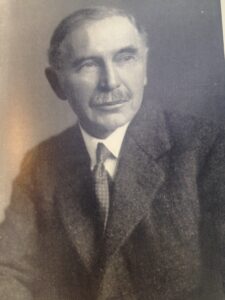
Although ‘scholarship boys’ such as Sir Michael Keane occasionally won through (the son of a Kerry tenant farmer, he entered the ICS in 1898 and served as governor of Assam in the 1930s), the centrality of Ireland’s elite education infrastructure to ICS recruitment meant that Irish appointees were overwhelmingly drawn from the demographics that could afford it; the gentry and more comfortable middle class.
The gentry element initially constituted a sizeable minority, accounting for 18 percent of the Irish Civilians recruited in 1855-1884. However, this figure gradually declined to a low of just 4 percent in the 1905-1914 period.[15]
There was often a strong economic basis for their decision to enlist: an ICS salary could partly compensate for declining estate revenues at home and it has even been suggested that Indian pensions ‘rescued the Irish minor gentry from total oblivion’.[16]
Initially Irish officials came predominantly from the gentry, then from the Protestant middle class, but middle class Catholics were represented too in significant numbers.
However, around 80 percent of Irish Civilians recruited in the second half of the long nineteenth century was drawn from Ireland’s Protestant middle classes, the sons of professionals (such as clergymen, doctors, and lawyers), merchants and businessmen, middle to high ranking Crown servants, and large farmers, who saw in the ICS an opportunity for ‘good pay, the promise of rapid promotion, challenge, adventure, prestige, and the satisfaction of leadership’.[17]
Ireland’s aspirant Catholic middle class, which became increasingly alive to imperial possibilities, saw the ICS in the same way and provided a steadily increasing proportion of Irish appointees, rising from 8 percent in 1855-1864 to 20 percent in 1874-1885 and 29 percent in 1905-1914.[18]
Most famous among them was Antony McDonnell from Mayo (ICS: 1865-1901) who, as lieutenant-governor of Bengal and the North Western Provinces and Oudh, earned a reputation as one of the most able ICS personnel to have served. Most notorious was Michael O’Dwyer from Tipperary (ICS: 1885-1919) whose highly controversial tenure of the lieutenant-governorship of Punjab culminated in steadfast support for the Amritsar Massacre of April 1919, in which several hundred unarmed Indian civilians were killed.
Irish Civil Servants in India
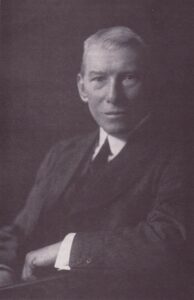
The ICS was quite unlike the ‘home’ civil services. Although it ultimately governed the lives of over 300 million people, it was never much more than 1,200-strong, forming in effect what David Lloyd George termed the ‘steel frame’ on which the ‘whole structure’ of British rule rested.[19]
Its fundamental administrative unit was the district, of which some 250 were eventually formed. Each was headed by a ‘district officer’ who, not only served as chief magistrate and revenue collector, but bore ultimate responsibility for law and order (including the police, prisons, and courts), hospitals and public health, agriculture, infrastructure, and schools.[20]
Generally-speaking, Civilians began their careers as an assistant to a district officer on one or more of his briefs and worked their way up through the service. For example, Michael O’Dwyer essentially began his ICS career as assistant (land-revenue) settlement officer in Shahpur, Punjab in 1886.
Michael O’Dwyer from Tipperary governed the Punjab from 1913-1919 and presided over the military’s firing on a civilian demonstration at Amritsar.
His success in the role saw him appointed to a series of increasingly senior positions, including director of land records and agricultural projects in Punjab (1896), revenue commissioner of the North Western Frontier Province (1901), acting political resident in Hyderabad (1908), agent to the governor-general of Central India (1910) and, finally, lieutenant-governor of Punjab (1913).
Keith Jeffery argued that the central question to be addressed in studies of the Irish contribution to the British imperial project is that of ‘whether the Irishness of imperial servants and settlers … made any specific difference to their experience and service’ and there is certainly a wealth of evidence demonstrating that it did in the ICS case.[21]
Michael O’Dwyer’s approaches to India were certainly informed by his Irish roots. His family’s targeting by agrarian agitators during the Land War (which he felt contributed to his father’s death) left him with a lifelong aversion to revolutionary violence. Although he initially supported Irish Home Rule, he came to believe that the campaign had served only to embolden Ireland’s rebellious element and he deplored the ‘terrible events’ of 1916-1922. O’Dwyer consciously applied what he saw as the lessons of Ireland to India.
Fearing that the constitutional campaign for Swaraj (self rule) would stir up India’s ‘revolutionary fires’, and believing that the country’s radical nationalists were inspired by ‘the growth and success of the separatist moment in Ireland’, he clamped down hard on protest. His determination that the Irish use of political violence be not replicated in the Punjab, and his contempt for the conciliation he believed had facilitated the 1916 Rising, defined his approach to the Amritsar massacre.[22]
In 1940, well after his retirement, O’Dwyer was assassinated in London by an Indian nationalist in revenge for the Amritsar shootings.
Some Irish officials were outspoken in their support for coercion of Indian nationalism, while others supported land reform in favour of Indian tenant farmers.
Kilkenny-born Civilian Loftus Otway Clarke took a similar view to O’Dwyer. Eighteen months after the 1916 Rising, he denounced as ‘Birrellism’ what he saw as the British-Indian government’s over-conciliatory approach to the Indian National Congress. This was a reference to Irish Chief Secretary Augustine Birrell, whose failure to clamp down on the Irish Volunteers many blamed for allowing the Easter Rising to happen.
Like O’Dwyer, Clarke believed that sedition’s suppression required early and firm intervention as ‘agitators’ such as ‘Sinn Féiners … naturally have nothing but contempt for a government which does not do its work’. And he too believed that the opening of fire at Amritsar was ‘absolutely right’.[23]
Other Civilians applied their Irish experience to India more positively. For example, to Catholic nationalists such as Antony MacDonnell and Charles O’Donnell, the north Indian socio-political hierarchies they observed were strongly reminiscent of those at home: they saw its Muslim communities as ‘not dissimilar from Irish Protestants in that they had effectively enjoyed a long monopoly over government office and land ownership’, while Hindus took the role of the oppressed Irish Catholic tenantry.[24]
And, together with other like-minded compatriot Civilians such as Peter O’Kinealy, Michael Finucane, and Patrick Nolan, they were instrumental in legislative reform, most notably the Bengal Tenancy Act of 1885. Some Irish Protestant officers also strived to improve the tenantry’s lot, their ‘variety of Irishness’ no less significant a factor. Most notably, the work on land reform of Louis Dane (a ‘old boy’ of Dr Stackpoole’s) as lieutenant-governor of the Punjab (1908-1913) was explicitly informed by his knowledge and experience of the Irish land issue.
Convenient Stereotypes
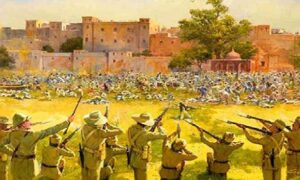
Irish support for tenant protections over landowner privilege did not go unnoticed in India.
During the debate on Bengal tenancy, one maharajah attributed MacDonnell’s actions to the fact that he was ‘an Irishman and Irishmen are generally against landlords’, while O’Donnell’s virulent, and sometimes public, condemnations of those responsible for what he considered anti-tenant policy were also seen to be derived from his Irish roots.[25]
The association of the attitudes and actions of Irish imperial servants with their Irishness was so commonplace in the Raj that Alexander Bubb has described it as the ‘foremost Imperial setting’ in which Irish character stereotypes were defined. These stereotypes (for example, subversiveness, stubbornness, indolence, drunkenness, impetuosity, a quick temper, a violent bent) were formulated largely around Irish soldiers and, in the case of Civilians, were not (and, indeed could not) be uniformily or consistently applied.[26]
A range of Irish stereotypes were applied to Irish officials, from the potentially disloyal ‘Fenian’ to the intemperate and violent supporter of government ‘coercion’
For example, in 1874 the Edinburgh Review warned that the India Office could not exclude ‘from among the Irishmen who are now pressing forward in shoals’ for the ICS ‘any number of Fenians or men who are rebels at heart from obtaining places; they have only to keep their political views out of the [examination] essay’ and some Civilians such as O’Donnell were accused of disloyalty in the British and Anglo-Indian press.[27]
However, others against whom accusations of subversive disloyalty were unthinkable were stereotyped in other ways. For example, Louis Dane’s elevation to the lieutenant-governorship of Punjab in January 1908 caused the secretary of state for India, Lord Morley, to complain that ‘Irish gentlemen … are not always accurate or sure-footed’; however, ‘if the Irishman, subject to attacks of “impetuous ideas” … is kept in his place by a solid-judging Scotsman, that will be quite enough for the peace-loving Englishman who is responsible for this mighty department at home’.[28]
So too with Michael O’Dwyer, who so conveniently fitted elements of the ‘fighting Irish’ and other tropes that he was nicknamed ‘The Gombeen Man’.[29] One of Morley’s successors, Edwin Montagu, dismissed him as ‘a little rough Irishman’ whose immediate recourse to coercion when dealing with political unrest was an Irish ethno-cultural trait, while others saw his Irish ‘quick temper’ and ‘impetuous nature’ as informing decisions which inflamed the unrest in Punjab which directly led to the horror of Amritsar.[30]
As the lieutenant-governor of the United Provinces put it in 1920: ‘Had we Englishmen in [the] places [of these ‘low bred’ Irishmen] the trouble would not have arisen, or would not have reached anything like the same dimensions’.[31]
Nonetheless, that most of the Irishmen thus stereotyped attained superior office suggests that anti-Irish prejudice did not translate into professional discrimination within the ICS. Fewer, certainly, were appointed to ICS places after the Amritsar massacre: the service’s principal Irish recruitment ground, TCD, produced just 23 Civilians between 1922 and 1938, when metropolitan recruitment finally ceased.
The Decline in Irish Recruitment to the ICS
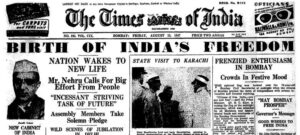
However, Irish representation in the ICS was already well on the wane by 1919. As the India Office noted in October 1922, ‘very few men [had] gone into the ICS from Trinity during the last 20 years’, an average of just two per year, and it made the first in a series of threats to defund TCD’s ICS school on that basis.[32]
Despite the failure of efforts to reverse this ‘falling off’ in Irish recruitment (for example, India Office departmental under-secretary, Sir Malcom Seton, and the former lieutenant-governor of the United Provinces, Lord Meston, travelled to TCD in 1925 in an effort to encourage interest) the ICS school limped on until 1937 when it was finally shut down.[33]
Few new Irish officials were recruited after 1922, due in part to the ‘Indianization’ of the Civil Service.
Furthermore, this postwar slump in Irish enlistments was not a localized phenomenon, but reflected a general crisis in ICS recruitment occasioned by the service’s diminished appeal as a career. First, there were reports that increasing anti-colonialism in India was giving rise to hostility towards Civilians, while political developments there were seen to call into question the permanence of British rule.[34]
Second, and far more significant, was what was perceived as the ICS’s inexorable ‘Indianization’ through increasing rates of examination success amongst Indian candidates. As early as August 1922, the Irish Times (which continued to publish the annual examination call throughout the interwar years) was warning that the ICS, ‘formerly a prize for the best brains of Trinity College no less than the English Universities’, no longer held much prospect for ‘brilliant young men in search of an administrative career’, when just one-quarter of the candidates sitting that year’s examination in London were ‘white men’.[35]
Attempts to stem this were instituted in 1925, when it was decreed that every 100 vacancies would henceforth be filled on a 50:50 basis. However, the extent of Indian examination success saw British representation in the ICS as an organisation continue to fall, causing the India Office such anxiety that limited recruitment by selection was introduced in 1936.
Nonetheless, Irishmen did retain a significant presence in the ICS after 1922. It continued to be promoted as a career in elite intermediate colleges and universities on both sides of the border and the new appointees in which this resulted joined over 100 previously recruited still serving Irish Civilians.
Thus, in October 1926, the London correspondent of the Irish Times could remark that both the ICS and the Indian Medical Service [IMS] had ‘an Irish membership out of all proportion to our island’s population’, while twenty years later, another of the newspaper’s columnists observed that: ‘it used to be said that India was governed by Blackrock College, and with a Cork accent, and there is no doubt that the proportion of Irishmen in the [ICS] and the [IMS] … is quite remarkably high’.[36]
India’s attainment of independence in 1947 saw the majority of the Irish Civilians then serving return home: as one retiree put it, it was ‘natural that we should wish to return to the country of our birth, where we have relatives and boyhood friends’.[37]
An Irish branch of the Indian Civil Service (Retired) Association was formed in summer 1949 to negotiate with the Irish, British and Indian governments their (mainly financial) affairs.
But most former Irish Civilians quietly lived out their lives below the public radar, closing a significant chapter in the history of Irish service in the British Empire.
References
[1] For an overview of this subject, see Thomas Bartlett, ‘The Irish soldier in India, 1750-1947’ in Michael Holmes & Denis Holmes (eds), Ireland and India: connections, comparisons, contrasts (Dublin, 1997), pp 12-29.
[2] This decision was taken in the context of a wider inquiry into patronage appointments in Britain’s home civil service.
[3] David Gilmour, The British in India: three centuries of ambition and experience (London, 2018), p. 81.
[4] Irish Times, 3 May 1922.
[5] Daily Express, 9 August 1862.
[6] Scott B. Cook, ‘The Irish Raj: social origins and careers of Irishmen in the Indian Civil Service, 1855-1914’, Journal of Social History, 20 (1987), pp 507-29, at pp 510-11; Bradford Spangenberg, ‘The problem of recruitment for the Indian Civil Service in the late nineteenth century’, Journal of Asian Studies, 30 (1971), pp 341-60, at p. 346.
[7] Irish Times, 25 February 1868.
[8] Anthony Kirk-Greene, Britain’s imperial administrators, 1858-1966 (Oxford, 2000), p. 93.
[9] ‘Sizars and servitors were undergraduate students who received financial assistances such as free fees, meal, or lodgings, sometimes in return for performing certain duties or tasks. J. M. Compton, ‘Open competition and the Indian Civil Service, 1854-1876’, English Historical Review, 83 (1968), pp 265-84, at p. 268; Edinburgh Review, 139 (1874), p. 337.
[10] Irish Times, 22 August 1870.
[11] Compton, ‘Open competition’, p. 271.
[12] Quoted in Kevin Flanagan, ‘The rise and fall of the Celtic ineligible: competitive examinations for the Irish and Indian civil services in relation to the educational and occupational structure of Ireland, 1853-1921’ (D.Phil. thesis, University of Sussex, 1977), p. 394.
[13] Some Irish Civilians so excelled in Indian languages that it defined their careers. Most notably, Max Macauliffe from Limerick (ICS: 1862-93) achieved such facility in the languages of the Sikh scripture the Guru Granth Sahib that he produced a still famous English translation, while Dubliner George Grierson (ICS: 1873- 1903) conducted an official linguistic survey of (most of) British India, during which he acquired a working knowledge of some 200 languages and dialects.
[14] Cook, ‘Irish Raj’, pp 511, 516.
[15] Ibid., p. 517.
[16] Keith Jeffery, ‘Introduction’ in Keith Jeffery (ed.), ‘An Irish Empire’? Aspects of Ireland and the British Empire (Manchester, 1996), p. 23 n. 99.
[17] Cook, ‘Irish Raj’, p. 511.
[18] Ibid., p. 516.
[19] Hansard, House of Commons, debates, Vol. 157, c. 1513, 2 Aug. 1922.
[20] ‘District officer’ was a generic term for the role which was differently titled in different provinces.
[21] Jeffery, ‘Introduction’, p. 17.
[22] Michael O’Dwyer, India as I Knew It, 1885-1925 (London, 1925), pp 9-13. See also, Sean Gannon, ‘Had we Englishmen in their place’ Sir Michael O’Dwyer and Amritsar.
[23] Kilkenny Archives, Maidenhall-Laviston collection, Loftus Clarke correspondence, Box 51 Clarke to mother, 7 Aug., 8 October 1917; Box 54 Clarke to mother, 18 July, 4 Aug. 1920.
[24] Barry Crosbie, Irish imperial networks: migration, social communication and exchange in nineteenth century India (Cambridge, 2012), p. 226.
[25] Ibid., pp 226, 243-5.
[26] Alexander Bubb, ‘The life of the Irish Soldier in India: Representations and Self-Representations, 1857-1922’, Modern Asian Studies, 46 (2010), pp 769-813, at p. 770.
[27] Edinburgh Review, 139 (1874), p. 337.
[28] Patrick O’Leary, Servants of the Empire: the Irish in the Punjab, 1881-1921 (Manchester, 2011), pp 144, 195.
[29] T. G. Fraser, ‘Ireland and India’ in Jeffery, An Irish Empire, pp 77-93, at p. 93 n.32.
[30] Edwin S. Montagu, An Indian Diary (London, 1930), 14 November 1917, 32.
[31] Gilmour, British in India, p. 97. Butler mistakenly believed that General Reginald Dyer, who ordered and oversaw the massacre, was Irish as well. Dyer was in fact an Anglo-Indian who had merely been educated in Ireland.
[32] Trinity College Dublin Archives, Board meetings minutes, MUN/V/5/22/280-81, Seton to Barnard, 14 October 1922; Dublin University Calendar, 1946-47 (Dublin, 1947), pp 479-82.
[33] Irish Times, 28 Feb. 1925.
[34] Irish Times, 13 Feb. 1922.
[35] Irish Times, 5 August 1922.
[36] Irish Times, 22 October 1926, 27 July 1946. Recruitment through competitive examination for the IMS was also introduced in the mid-1850s, resulting in an over-representation of Irishmen in its ranks that lasted until at least the 1930s. Seán William Gannon, The Irish imperial service: policing Palestine and administering the empire, 1922–1966 (Cham, 2019), pp 188-191, 196-7.
[37] British Library, Asian and African Studies Collection, Mss Eur F 173 Indian Civil Service (Retired) Association, Healy to Martin, 7 Mar. 1949.